Devil Survivor 2: A Smart, Refined Elaboration on the Alternative
The original Devil Survivor was an interesting case study of sorts. At its core was an SRPG with an anti-SRPG heart. The same basic things were as important to success and victory in Devil Survivor as they are in other SRPGs, but they were handled with a far different mentality. Rather than throw lots of vague variables in your face and tell you to find some sort of meaning behind the madness, Devil Survivor kept your concern rooted in only a few clear things at any given time. The depth and difficulty therefore came not so much from trying to wrap your head around a lot of dense material, but rather how well you could exploit the fundamentals as your understanding of them broadened over time. In these regards, Devil Survivor 2 is very similar functionally and philosophically to its predecessor. Nothing is really reinvented so much as cleaned up and improved and that might make it easy to discount early on. That's actually a good thing, though, as with the help of some smart expansions and refinements upon what was already a really solid gameplay base, the sequel ultimately makes an even better case than the original game as to why its brand of SRPG gameplay is a viably enjoyable alternative to the genre's norms. (Reviewer's note: This review is based only on the content of the Japanese version of the game. A localized edition is coming out in North American in February 2012 and while it's likely that, translation aside, the content of that version will be the same, that guarantee cannot otherwise be made within the scope of this text.)
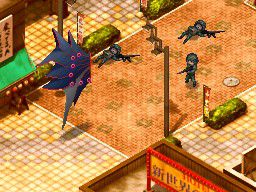
As such, the basic premises driving both the gameplay and the narrative of Devil Survivor 2 are much like those of the first game. Placed in the midst of a Japan ruined simultaneously by natural disasters and the appearance of Atlus' now-iconic stable of demons, as well as some comparatively foreign-looking aliens, your only task at hand is your own survival over the course of several days. To do this, you are bestowed with two things early in the plot: a website with videos that can depict the future deaths of both yourself and your friends, as well as the ability to make contracts with and summon the very demons terrorizing your homeland. You're given these tools without the implicit expectation that you'll become a hero by default; life and limb are to be given more importance than your morals. Indeed, if you can simply survive in one piece and make it to the end, whatever that might actually be, that's reason enough to call it a success. If you can do so while working on your own terms, then you're simply making the most of your situation.
To accomplish all of this, as in the original game, Devil Survivor 2's gameplay is still split up into a few distinct phases. In battle, you and the enemy once again work in teams of three (in the case of you and your allies, one person and two demons) on an isometric grid, with actual fighting commencing in miniature skirmishes formatted like a regular turn-based RPG. At most, you have two turns to wipe out as much of a given unit's combatants before being returned to the battlefield to receive any applicable experience points and money, with subsequent units then being given a chance to move and attack. Additionally, you still choose how each of your allied teams are set up prior to sortieing and can activate abilities outside of battle, as well as permanently steal the enemies' for later usage. Outside of combat, you again advance the plot in 30-minute chunks by deciding who, what, and where you want to visit at any given time. Doing so enables you to get to know various members of your team and opens up various side-stories that occur in tandem with the main plot line. These naturally feature a basic dialog system that affects both the flow of conversations, as well as which ending you ultimately encounter. You'll also manage your repertoire of allies, demons, and abilities in your free time through means that are, once again, familiar to those who played the previous game. You can acquire new demons through both an auction system and the ever-present Shin Megami Tensei fusion system, with the latter's ability inheritance mechanics once again driven solely by what you want your new demon to carry on from the parent ones and not by dice rolls.
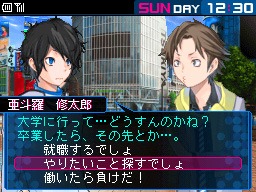
Those who have played Devil Survivor before will already be completely familiar with how these systems basically work and, especially for new players, they once again remain pleasantly straightforward and make the core SRPG gameplay accessible even to those who might otherwise be hostile towards the genre. What prevents Devil Survivor 2 from merely being the same game with a different cast of characters are the numerous additions and changes Atlus has made to the gameplay. They're mostly small and don't overly change the sort of game that Devil Survivor 2 is deep down, but they're all meaningful and add up to make for a fuller game than the previous offering. The most superficially obvious of these enhancements from the game's inclusion of a social system not-unlike Atlus' recent Persona games. As you talk to characters and advance their individual storylines, you'll unlock a few different things. A good portion of them are just powerful demons that you can later fuse, but two items that you unlock are directly related to combat. The first of these affects the previously-mentioned enemy skill stealing, otherwise known as "skill cracking." When you get to better know a character, the two of you can have different skills to target for cracking that can nevertheless be mutually unlocked by either one of you. You're still limited at cracking four skills at most per battle, but now multiple characters can potentially crack the same skill without sacrificing the chance to crack a different skill as well, a delicate balance that had to be constantly struck in the previous game. Should you become even closer to a character, you can also eventually transfer demons from your respective parties to each other, although this only handy in emergency situations.
A lot of enhancements have also been made to how you recruit and raise demons as well, though. The standard eBay-esque auction system of the previous game that let you spam your way to a bargain and submissive opposing bidders has instead been replaced with one where you place only one bid to determine whether you win and can recruit a given demon. However, you get a preview of the general price the other auction participants are willing to pay before the auction starts and you can also see emoticons that determine whether they've gone over or under that baseline before you submit your bid last. This adds both some strategic and sheer gambling elements, since you ideally want to win every auction without going extremely over what other people bid. The original system does, however, appear on occasion in the form of special auctions that are triggered randomly, but you still can't input a new, slightly higher bid as much as Devil Survivor 1 allowed. Aside from that, a demon compendium, a common sight in most mainline and spinoff SMT games, is now accessible at any time outside of combat, allowing you to register your current stock of demons as well as summon any previously registered ones again for a price.
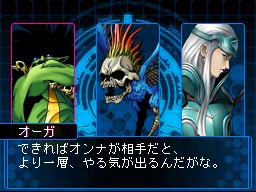
The fusion system has changed the least, still featuring the same extremely useful appendix that lets you see your desired result and what combination of demons you either possess or have unlocked that will combine into it. A major addition has nonetheless been introduced to the fusion proceedings. Aside from being able to choose at will what exact set of abilities the new demon will inherit aside from ones it'll naturally gain from levelling up, you can also choose to apply optional, single-use unlocks that further affect the end result of the fusion. These can range from increased skill points to even choosing abilities to give your demon that come from your own stock of cracked abilities, something that is extremely handy for either giving the demon a bigger edge and/or covering up a weakness. The unlocks themselves are acquired by performing exceptionally well in battle and you can only keep six of them at a time, making them powerful tools that require a delicate touch to utilize well. While this level of manipulation was hardly a glaring omission from the first game by any means, it introduces even more welcome customization to a game that already allowed a lot of your own input.
What all of this adds up to in practice is a game that now lives up to its premises better than before. Both the way in which battles specifically play out and how the plot unfold are determined almost entirely by how you choose to approach them. All Devil Survivor 2 actually does for you as a game is present you with situations and information to give you something over which to mull in the first place. Battles, for instance, are always set up such that you can always know the strengths, weaknesses, and abilities of all of your enemies, even before your first turn commences. Beyond that, though, the game leaves it up to you to decide how to approach the oncoming fights, especially thanks to the ability to completely swap out and retool the human characters' abilities any time before combat. There's no predetermined way that you're supposed to defeat any member of the opposition to the extent that you're allowed to determine what specific roles your team and the other allied teams fulfill. Nothing is set in stone and as a result of that, even when the game gets difficult, the key to success never feels out of reach. If something isn't working the way you like, you simply switch up how the characters operate and be on your way. The game has no one right answer for any situation and it's to its benefit that you're allowed to improvise as much as necessary without being punished for it.
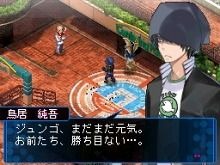
Likewise, even if the sense of choice in plot is, predictably, limited to just dialog choices, the implications they have give you a good sense of personal consequences for your words and actions, affecting more than just what ending you see. Different characters have different ideas of how to cope with the various crises in the game and there are various points where you'll be made to pick a side of some sort. The important thing to note, though, is that the sides aren't just limited to "one side versus the other." You're also often given the option to strike it out on your own and tackle a situation according to your own moral code, even if that ruffles some feathers and makes you a third faction in a fight that's about to break out. Even the way you choose to spend your time between major plot battles can have important facts for how things unfold and the way you play the game later on. Characters can outright die, for instance, if you spend too much time dawdling around instead of focusing on the task at hand simply because the game gives you the chance to procrastinate. Conversely, if you don't figuratively stop and smell the roses on occasion and pursue side stories, you'll potentially miss out on events that provide important context for character motivations that could determine how you react around them later on and that's not just with regards to the Social Link-like events. The actual paths that you can come across and travel ultimately unfold in a linear manner, but Devil Survivor 2 gives you enough to choose from over the course of the game that the act of making those decisions feels more than just a purely binary matter.
These are all accomplishments that Devil Survivor 1 had as well. The reason why they feel even more pronounced in the sequel is that the new gameplay additions serve to accent the basic ideals that now define the series. The new relationship system, for example, gives you tangible reasons in terms of both plot payoffs and gameplay benefits to actively favor characters and choose to spend time with them. You'll likely end up unlocking the important features for most of the characters by the time you reach the ending, but the order in which you unlock them on a character-by-character basis still greatly affects how you plot individual battles and who you bring into them. The relationship system also goes far in making you feel invested in the central conflicts since you'll see characters take sides on various matters as you get to know them and you'll be made to determine how much the relationship they've crafted with you is worth. Do you try to appease them in a dire situation simply because you like them so much or do you take a firm stance in contrast to them? If it's the latter, is it because you simply can't make that sort of compromise or it precisely because you're a friend and feel the need to show them why they're wrong? Devil Survivor 2 lets you make these sorts of considerations on a regular basis and, much like how you approach battles, there is no right or wrong, good or bad approach. The game simply wants you to be yourself and it'll unfold accordingly, lacking anything in the way of an alignment indicator beyond the status of your relationships. As mentioned previously, the way you strategize for battles and prepare for them also feel as though they're similarly enhanced as a result of the additions and tweaks made to Devil Survivor 2, creating an experience that's just more in tune with your whims than what was available in the previous game.
All of this isn't to say that Devil Survivor 2 lacks its caveats, though. Many of the more glaring issues are actually related to the story and characters. Put simply, for all the urgency the game puts in the survival situation into which you're thrust, it takes a bit too long for things to get consistently interesting. Part of this probably because of the sheer amount information that's necessary to convey early in the game to set things up and keep the player aware of what's happening, but it still feels as though it takes longer than it should for Atlus to show the various aces it really does have up its sleeve for the plotline. When it actually reaches that point, the game is consistent about maintaining the sense of referential intrigue, especially since it alludes to a lot of new concepts for Shin Megami Tensei games in general (some of which are even outside of world religions) that give you a lot to contemplate in addition to the usual moral ambiguities. Up until that point, however, the plot still tends to drag before that point.
The quality of the characters themselves and their individual stories that unfold during the relationship portions also vary somewhat. None of the characters nor their stories are outright bad, but, similarly to the main plot, they have a bad habit of sticking to worn tropes for too long before they show their true colors. Thankfully, nobody is as superficial as they first seem and they all have their reasons for acting as they do, yet that doesn't quite excuse the fact that they let you hold onto your first impressions of them for quite a while without alluding to something greater at work. Furthermore, many of their stories that you'll see during the relationship segments also don't seem to really have much in the way of closure. Perhaps it's because you're getting to know them in the midst of a disaster and as such it's hard to have that sense of fulfillment when nobody knows whether they'll make it to the next day, but it's often jarring to have a seemingly random event pop up and then subsequently get the notification that you had, in fact, finished a character's story and unlocked everything from them that there is to unlock.
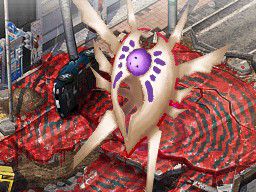
Beyond that, while most of the major gameplay issues from the first game have been addressed, there are still a few minor things that have surprisingly not been corrected. The most irksome of these stragglers is the continued inability to view your backup stock of demons mid-battle without forcing one to return from your team and then using the option to summon another one. Given how this uses up the one action per turn alloted to your human characters and helper monsters outside of battle, it can be a waste of resources if it turns out that you had no better alternatives and have to waste the action for that turn returning things to the status quo. Like in Devil Survivor 1, this isn't a make-or-break issue, but there's still no reason from a gameplay balance perspective to forbid you from checking up on your demon stock without that hassle. In addition, you also strangely can't check up on the stat points of your party or the opposing team's during battle. You can still see everyone's abilities and strengths/weaknesses, but the stats themselves are only viewable while you're on the isometric battlefield. This is also not a major issue and would only be apparent to those who are veterans of the series, but it's noticeable that three years later, Atlus still hasn't added that feature as well, as it can be handy to have under certain strategic conditions. Having said that, when considering that the most glaring issue from the first game, which was the seemingly endless number of tedious civilian rescue missions, has been corrected, these issues are mostly inconsequential and do little to hinder the overall enjoyment. But the fact that they're still present if you know how and where to look for them is still disappointing to see.
Some art asset recycling from the first game also occurs; while all of the main characters are new and drawn with new artwork by series mainstay Suzuhito Yasuda, many of the battle sprites and character portraits generic civilian and military NPCs you encounter are reused wholesale from the first game. There's also an odd relapse in comparison to the last DS Shin Megami Tensei game, Strange Journey. Whereas that game featured animation for all 300-plus of its enemy demons when you encountered them for fights, Devil Survivor 2 surprisingly has no animation again whatsoever. Even if some of the demons featured in Devil Survivor 2 are all new, it's strange to know that the feature isn't there despite the number of available demons being significantly less than that of Strange Journey. A couple of battlefields from the first game also reappear with some regularity towards the end of the game, although this occurs only when you're fighting in Tokyo and makes some sense given how, unlike 2, the first game took place solely within Tokyo. Given that the majority of the game now occurs in other parts of Japan outside of Tokyo, the majority of artwork you do see for locations and battlefields are thankfully all new, making the ones that do make a cameo less pronounced than they probably otherwise would be.
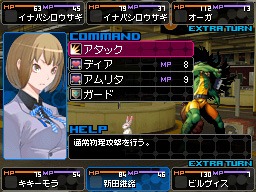
Aside from the recycling issues, the artistic quality on display in Devil Survivor 2 is by and large solid. Whether you like Suzuhito Yasuda's character designs is going to be a personal matter, especially with regards to how flatteringly he draws female characters, but aside from that, all of the artwork that is present in the game is about as crisp and detailed as one could expect for both a game of its genre and as a DS game in general. Many of the locations that the game takes you to are drawn to deeply resemble their real-life counterparts, which, for those either personally familiar with the areas in question or at least have done extensive research, adds some extra gravitas to the proceedings when you visit them and see them rendered in a distraught state. Atlus also ensured that the game's menus and user interface look pleasing when navigating them, which is appreciated, since so much time is naturally spent navigating them. The music present in the game also displays a similar level of competence. No real standout pieces play in the game until the final stretches, although many of the regular pieces that play throughout the game do have stylistic resemblances to the Persona series'. While they sometimes sound a bit too similar to Atlus' other social RPG series in terms of tone and the instruments used, they're otherwise pleasant enough and add some flair to what would otherwise be mostly generic-sounding pieces.
While SRPGs tend to be slaves to tradition in terms of their gameplay and overall presentation, Devil Survivor 2 can only be regarded as such if compared to the previous game. The overall gameplay experience is largely similar to the first one and as such, even with the enhancements and additions, it doesn't feel quite as fresh as the first game. But the only reason why that's the case is simply because the first game already existed to prove that there was, actually, a different way to handle SPRG gameplay without being overwhelming. That probably means it won't win anybody over who didn't like Devil Survivor 1's formula, but at the same time, the changes brought to Devil Survivor 2 also allow it to be even more welcoming to those who normally can't handle or dislike SRPGs. Even in the face of a slow-to-begin story and the surprising inheritance of a few issues from the last game, on its own merits, Devil Survivor 2 does a great job of carrying its series and alternative approaches forward, bringing appreciable additions that make an already refined formula sharper than ever.
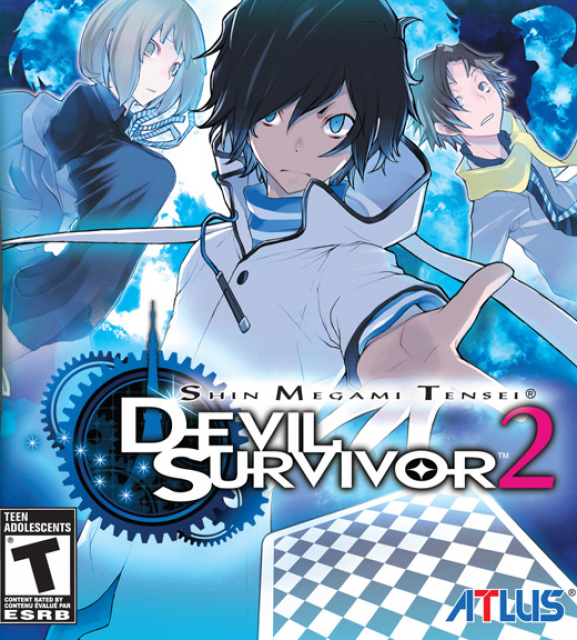
5 Comments